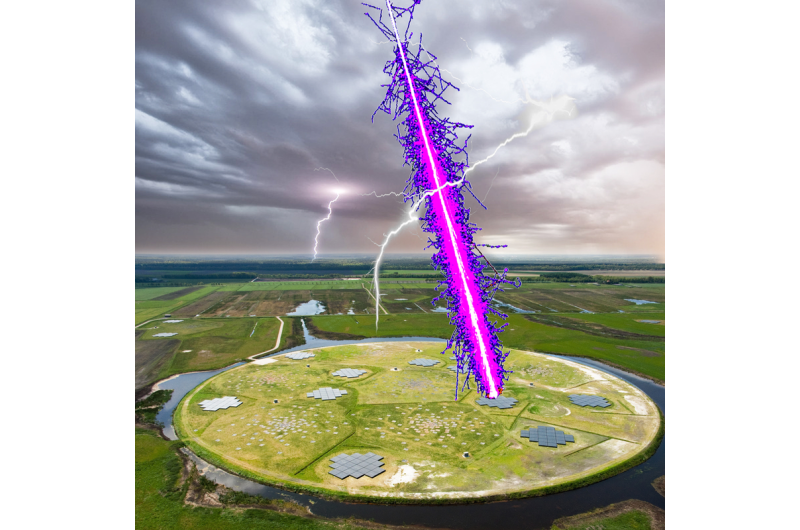April 30, 2015 report
Astronomers use space particles to measure electrical field in thunderstorms

(Phys.org)—A very large team of European astronomers has found that they were able to measure the degree of electrical activity in thunderstorms using information derived by collisions of space particles with Earth's atmosphere. In their paper published in Physical Review Letters, the researchers describe how they used data obtained over a several year period from an observatory to calculate thunderstorm voltage activity.
Despite living with thunderstorms for our entire existence, we humans still do not really know much about the lightning they spawn, and worse when and where such strikes will occur. One bit of information scientists would like to have is the amount of electricity produced during storms, which could help reveal more about the formation of lightning. Getting that information has been difficult because storms are unpredictable and the tools available for research efforts are not optimal.
In this new effort, the research team found a completely different way to measure the electrical field in a thunderstorm—by tracking secondary particles that are produced when cosmic rays collide with atmospheric atoms, or when gamma rays decay into pairs of electrons. In both cases, the result is a shower of particles falling to Earth in a predictable way. It was that predictability that allowed researchers to use them to measure electrical patterns in thunderstorms. If a thunderstorm passes over an observatory, the researchers inside are able to detect changes in the trajectory of such secondary particles that result due to interaction with electricity in the clouds.
By plotting the trajectories of a lot of the particles that fell in the past (over the years 2011–2014 using the Low Frequency Array (LOFAR) radio telescope in the Netherlands) the researchers were able to note changes wrought by thunderstorms (changes in trajectories versus times when there were no storms) and to make out where the electricity was in those storms (by creating a computer simulation) and how much was there.
In looking at the data, the researchers were able to confirm a theory that suggested that thunderstorms have two layers of electrical activity—the gradient ran from 50 kV/m in the upper layer, to 27 kV/m in the lower layer. The team believes their findings could lead to further studies being conducted with the aim of helping to better understand the nature of lightning in storms in general, and perhaps leading to ways to better predict when lightning strikes will occur and where.
More information: Probing Atmospheric Electric Fields in Thunderstorms through Radio Emission from Cosmic-Ray-Induced Air Showers, Phys. Rev. Lett. 114, 165001 – Published 24 April 2015. dx.doi.org/10.1103/PhysRevLett.114.165001 . On Arxiv: arxiv.org/abs/1504.05742
ABSTRACT
We present measurements of radio emission from cosmic ray air showers that took place during thunderstorms. The intensity and polarization patterns of these air showers are radically different from those measured during fair-weather conditions. With the use of a simple two-layer model for the atmospheric electric field, these patterns can be well reproduced by state-of-the-art simulation codes. This in turn provides a novel way to study atmospheric electric fields.
Journal information: Physical Review Letters , arXiv
© 2015 Phys.org




















